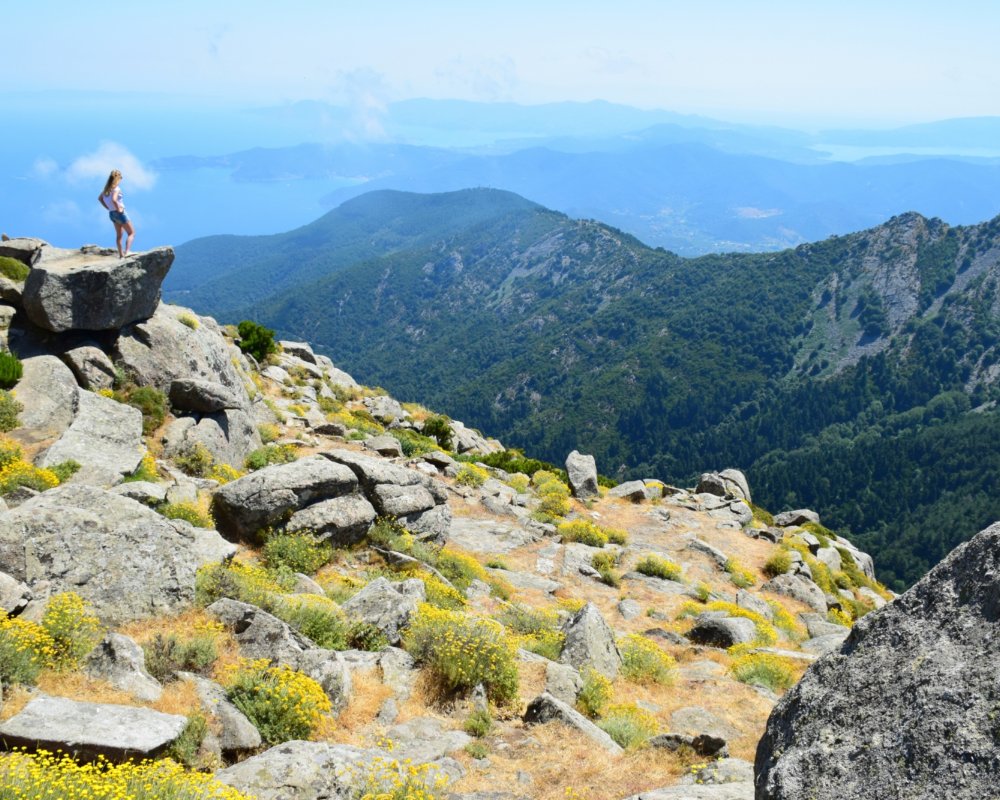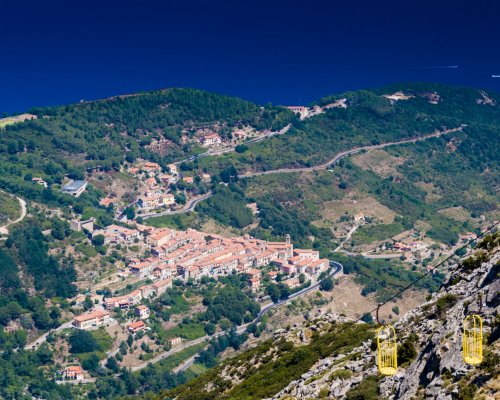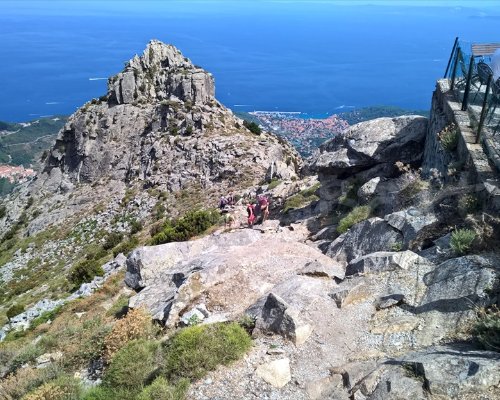An incredible ride between sky and sea on the island of Emperor Napoleon
Legend says that when Venus, the goddess of beauty and love, was immersed in the waves of the Tyrrhenian Sea, the splendid tiara she was wearing around her neck broke and seven precious gems fell into the sea, transforming, out of divine metamorphosis, into islands. Thus were formed Giglio, Capraia, Gorgona, Pianosa, Giannutri, Montecristo and Elba.
On the largest island in the Tuscan Archipelago, the Mediterranean atmospheres blend with the extraordinarily varied nature, in which granite, limestone, endless forests and the crisp air of the mountains create a one-of-a-kind cocktail of nature and history. Elba also conceals a precious treasure underground: the iron and pyrite mines were among the oldest iron-yielding deposits in the world to be mined and for centuries launched the island into the spotlight for its never-ending mining resources, sought by the greatest powers in Europe. The mining activity on the island continued for over two thousand years before coming to end in 1981 when the last mine, Galleria del Ginevro, was closed.
Elba is an island that deserves to be walked, possessing a magnificent coast of 147 kilometres of cliffs, beaches and coves. But in addition to the beauty of the island’s waters, Elba boasts an important patrimony of nature, characterized by a lush vegetation that has earned the island a spot among the greenest in the whole of the Mediterranean. And thanks to this precious heritage, it’s the ideal destination for excursionists who find here both the pleasure of discovering the beauties of nature and a thousand-year history of the most important civilizations in the Mediterranean.
The Great Elban Crossing is an impressive hiking route, considered one of the most beautiful walks in Italy, which unfolds primarily on the ridge of the island’s mountain. The whole journey can be done in four to five days, through hiking single stretches is just as doable.
The walk allows visitors to see all the ecosystems present on the island and its varied nature, from the coasts to the forests, before arriving at the peak of Monte Capanne, over 1,000 metres high, from where you can enjoy one of the most fascinating views offered by Italy’s mountains.
The route stretches along the ridge of Elba’s mountain chain, with plenty of opportunities to view your surroundings in every direction, allowing you the chance to enjoy infinite panoramas of Corsica, the Tuscan Archipelago and the Italian peninsula while discovering the wonderful blossoming of the Mediterranean scrub.
From Cavo, walking through plants of rockrose and rosemary, climb toward the panoramic Monte Grosso (348 m), where you can find a well-preserved military post used by soldiers during World War II (“Il Semaforo”). Now head down and cross through Valle delle Fiche, after which you’ll climb Monte Strega (425), from the peak of which you can see the iron mines below. Walking along the ridge, you’ll arrive at the third peak, Monte Capannello (406 m), offering an excellent view of Rio Elba and the bays of Bagnaia and Nisporto. After the “Panche” pine forest, or pineta, you’ll come across the highest point of the hike: Cima del Monte (516 m), overlooking all of eastern Elba. Once you get past Piana della Principessa (an archeological site), you’ll be at Monte Castello (389 m), from where you can see Valle del Monserrato and Porto Azzurro, which you can reach by walking through olive groves and vineyards.
From Cavo, walking through plants of rockrose and rosemary, climb toward the panoramic Monte Grosso (348 m), where you can find a well-preserved military post used by soldiers during World War II (“Il Semaforo”). Now head down and cross through Valle delle Fiche, after which you’ll climb Monte Strega (425), from the peak of which you can see the iron mines below. Walking along the ridge, you’ll arrive at the third peak, Monte Capannello (406 m), offering an excellent view of Rio Elba and the bays of Bagnaia and Nisporto. After the “Panche” pine forest, or pineta, you’ll come across the highest point of the hike: Cima del Monte (516 m), overlooking all of eastern Elba. Once you get past Piana della Principessa (an archeological site), you’ll be at Monte Castello (389 m), from where you can see Valle del Monserrato and Porto Azzurro, which you can reach by walking through olive groves and vineyards.
From the town of Porto Azzurro, dominated by the 18th-century Fortress of San Giacomo, climb the Valle, or valley, of Botro. From Capo Galletti, cross through Valle del Buraccio until you reach the vineyards at Casa Marchetti. Once you’ve arrived at the panoramic Monte Orello (377 m), dotted with military fortifications, walk down through an ancient forest of cork oak until you come to the “Fonte agli Schiumoli” and Passo di Colle Reciso (200 m). From Poggio del Molino a Vento (288 m), climb up to the mountains Barbatoia (369 m), San Martino (360 m) and Tambone (377 m); this last mountain offers one of the most spectacular views of Elba. Climb down in the direction of Marina di Campo to end the excursion on the beautiful white sand beach.
From the town of Porto Azzurro, dominated by the 18th-century Fortress of San Giacomo, climb the Valle, or valley, of Botro. From Capo Galletti, cross through Valle del Buraccio until you reach the vineyards at Casa Marchetti. Once you’ve arrived at the panoramic Monte Orello (377 m), dotted with military fortifications, walk down through an ancient forest of cork oak until you come to the “Fonte agli Schiumoli” and Passo di Colle Reciso (200 m). From Poggio del Molino a Vento (288 m), climb up to the mountains Barbatoia (369 m), San Martino (360 m) and Tambone (377 m); this last mountain offers one of the most spectacular views of Elba. Climb down in the direction of Marina di Campo to end the excursion on the beautiful white sand beach.
From Marina di Campo, cross the paved stone streets, turn onto the path in the town of Le Piane and after passing by the still-active granite mines, you’ll reach the Moncione water mill (366 m). This is also where Roman-era granite mines can still be found. Leaving Vallebuia to your right, head up toward a large granite monolith: Pietra Murata (548 m). From “Le Macinelle” (600 m), you can also visit “Colle della Grottaccia” (645 m) and the “Filicaie” crossroads (870 m): from Monte Capanne (1019 m), you can get a glimpse of the entire island. Now climb back down toward the north, between large sheets of granite, until you reach Sella del Ferale (620 m) and finally, the streets of Poggio (350 m).
From Marina di Campo, cross the paved stone streets, turn onto the path in the town of Le Piane and after passing by the still-active granite mines, you’ll reach the Moncione water mill (366 m). This is also where Roman-era granite mines can still be found. Leaving Vallebuia to your right, head up toward a large granite monolith: Pietra Murata (548 m). From “Le Macinelle” (600 m), you can also visit “Colle della Grottaccia” (645 m) and the “Filicaie” crossroads (870 m): from Monte Capanne (1019 m), you can get a glimpse of the entire island. Now climb back down toward the north, between large sheets of granite, until you reach Sella del Ferale (620 m) and finally, the streets of Poggio (350 m).
From the village of Poggio, cross through the chestnut grove until you reach the Benedictine hermitage of San Cerbone (531 m), cut through all of Valle di Pedalta and turn onto the cobblestoned Via Crucis that connects the town of Marciana to the Sanctuary of the Madonna del Monte (630 m). From this place of worship, carry on toward the overlook that was inhabited in pre-historic times: Masso dell’Aquila (634 m), from which you can see the entire northern coast of Elba. Head down toward the small Bollero spring and, still walking in the shade of the chestnut grove, climb back up toward Troppolo. In the direction of Pomonte, you’ll reach Terra (600 m), and from here you can begin your descent toward Valle di Pomonte, where terraced vineyards – almost completely abandoned – will flank the route, finally arriving at the town of Pomonte.
From the village of Poggio, cross through the chestnut grove until you reach the Benedictine hermitage of San Cerbone (531 m), cut through all of Valle di Pedalta and turn onto the cobblestoned Via Crucis that connects the town of Marciana to the Sanctuary of the Madonna del Monte (630 m). From this place of worship, carry on toward the overlook that was inhabited in pre-historic times: Masso dell’Aquila (634 m), from which you can see the entire northern coast of Elba. Head down toward the small Bollero spring and, still walking in the shade of the chestnut grove, climb back up toward Troppolo. In the direction of Pomonte, you’ll reach Terra (600 m), and from here you can begin your descent toward Valle di Pomonte, where terraced vineyards – almost completely abandoned – will flank the route, finally arriving at the town of Pomonte.


